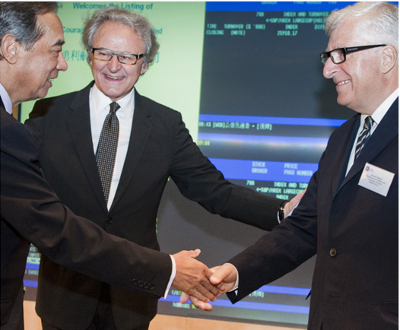ESCP Professor Alberta Di Giuli killed two birds with one stone, winning awards from The Case Centre as well as the AFFI for a case study about Prada’s Hong-Kong IPO.
ESCP Professor and LabEx ReFi member Alberta Di Giuli won the Finance, Accounting and Control category at The Case Centre Awards and Competitions 2018, as well as the award for best case in Finance from the AFFI (Association Française de Finance or French Association of Finance), for the case study about the Prada group’s very successful Hong-Kong IPO she wrote with HEC’s Denis Gromb. The Case Centre online platform publishes case studies in all disciplines of business authored by the faculty at leading business schools worldwide, and "Prada’s Hong Kong IPO" is featured in its list of best-selling cases for 2017. Originally published in French and English by CCMP (Centrale de cas et de médias pédagogiques, or Case and pedagogical media centre), this case study offers an opportunity to discuss the pros and cons of the IPO that a team at one of Prada’s underwriters, Crédit Agricole’s CLSA unit, was preparing in March 2011 on the Hong Kong Stock Exchange, to value a company going public, to structure the offering of the IPO set for June, and to review the IPO process.
A crucial step for the Prada group
The iconic Italian luxury group, which produces and designs Prada leather goods, footwear and ready-to-wear clothing, is also home to Miu Miu, Church’s and Car Shoe. Prada had already made four attempts at an IPO listing, but a post-9/11 market gloom and the 2007/08 global financial crisis put pay to these efforts. “The acquisitions’ debt burden nearly broke the company’s back”, say the case authors to explain Prada’s that the holding and operating companies found itself over one billion euros in debt due to a series of ill-fated acquisitions at the turn of the millennium. So an expected near two billion euro windfall from floating shares on the Hong Kong Stock Exchange was an extremely attractive proposition – hence Prada’s fifth attempt to become the first Western luxury listing in the autonomous territory, and former British colony, in south-eastern China.

This case is all the more interesting since Maria Miuccia and Patrizio Bertelli, Prada’s Head of Design and CEO, as well as owners, had a difficult decision to make in regard to Prada’s valuation: lowballing could mean a lot of money left on the table, and overshooting created the risk of a dismal performance at the IPO and in the aftermarket.
A case that stands out
The case study is based on field research carried out within the team which prepared and implemented the IPO, which was made possible by the coauthors’ proximity to Laurent Pellerin at Crédit Agricole. “Taking the field research option was absolutely vital on this case, they explain. We do not disclose anything extra-sensitive but help from Laurent Pellerin was crucial, especially for the material in the teaching note and handouts.”
They wrote their case for students in different programmes at ESCP and HEC Paris, but its dissemination was not anticipated. “Yours is a stand-out case”, said The Case Centre Director, Richard McCracken, during the prize ceremony. “That’s for several reasons: it was written for and with your students; the choice of a global brand like Prada gives it universal appeal; and the teaching notes you wrote to accompany it are so strong that institutions on the other side of the world can adapt it to their own context.”
The topic they chose clearly made it appealing: “We like cases that offer opportunities to explore different side issues depending on the interests and expertise of participants: family businesses, luxury in China, Denis Gromb and Alberta Di Giuli added. We wrote the Prada case with these ideas in mind. We can teach it twice on the same day and have equally interesting but totally different class discussions and dynamics.”
Their work met with success even though case studies are not necessarily associated with finance. “To us, corporate finance cannot be taught – let alone practiced – in thin air, they said. It’s important to understand the basic drivers of the business, its products, its customers. That’s why we like finance cases with a rich business context. They also avoid thinking in silos and allow participants to build bridges across disciplines.
Icing on the cake
 Richard McCracken noted the challenge of winning a case study method resource: “Over 60,000 cases from 31 countries are eligible for our 14 annual awards each year. Since it went on the market, your case has been taught in eight different schools in four countries, it’s worked on by hundreds of students – no mean feat.”
Richard McCracken noted the challenge of winning a case study method resource: “Over 60,000 cases from 31 countries are eligible for our 14 annual awards each year. Since it went on the market, your case has been taught in eight different schools in four countries, it’s worked on by hundreds of students – no mean feat.”
“It’s great to know it’s being picked up by other schools too, the authors added. The award is the icing on the cake.” But it’s also the way they designed it which made it possible to be used with other audiences: “We wrote the teaching note and additional material (slides, spreadsheets) for ourselves, they explained. We needed enough details to pick from so the case could be easily used in different ways for different audiences, from undergraduates to MBAs to executives.” As a matter of fact, they also wrote an abridged version of the case, available via The Case Centre as well as CCMP. “We find that it works well with executives who must analyse the case in teams during the day, or in other programmes where participants have limited time to prepare between sessions. The richness of the full case can then be used during the debrief.”
Campuses
